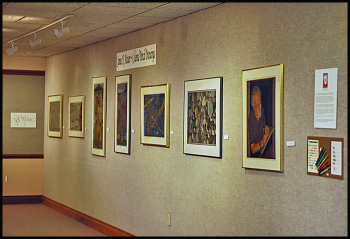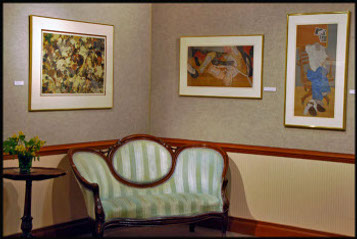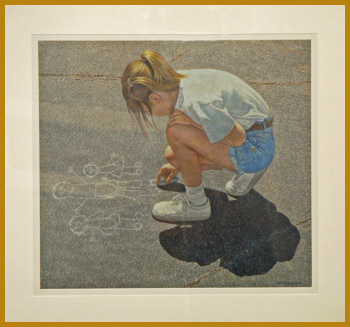JAMES K. MATEER: DRAWINGS
Kendal Gallery, April-May 2009


From first glance it's evident that James Mateer's remarkable drawings are composed with a photographer's eye; in fact, some viewers move in close to see if they are really photographs.
The drawings of the Florida everglades and Cornwall's St. Ives arewide-angled, panoramic. The other drawings, all of them of rural Ohio subjects, are composed straight on, frontally, often close-up; they are carefully framed, sharply focused, limited in perspective and depth of field. The artist himself speaks of the “photo realism” of “Old War-Horse,” his drawing of a massive, rusty 1920s-era farm tractor. Nearly all of these works are, he tells us, based on digital photographs he himself has taken.
They are drawn with Primacolor pencils, using a technique of cross-hatching, shading, layering, and smudging he has perfected over the past fifteen years. He uses various kinds of cross-hatching, illustrated on the sample sheet posted at the entrance to the show and somewhat reminiscent of the techniques used in 18th c. copperplate engravings. They are executed with the same kind of patience and steady hand, meticulously (with electricpencil sharpener always in reach), usually over a period of weeks or even months. Interestingly he has gone one step further with “Gourds,” by digitally photographing the drawing and with high-tech equipment making absolutely color-perfect reproductions.
The only work in which the human figure is represented is “FamilyPortrait”, one of the loveliest in the exhibition. In it a little girl, alone in a corner of the schoolyard, totally absorbed, is “caught” by the camera, chalk in hand, having just decisively put the final touch to her portrait of three stick-figures. Viewed close-up, hatching marks speckle on bare arms and legs; at a distance, all fuses beautifully into an image of soft blues, greys, and white, set off by the rough pavement and dark shadow of her figure.


The highlights of the show, along with "Family Portrait," are the close-up, carefully framed drawings of corn cobs ...of honey bees swarmingover the hive ....of gourds, pimply and glistening in a heap ....of mossclinging intrepidly to fissures in "real" rocks .... of autumn leaves, fallen, and undisturbed by even the slightest breeze. The most memorable of these is the timeless, relief-like image of stones and pebbles in a stream bed gonedry. Take your time before this relief, look closely at the shape, contour, surface, texture, and weight of each stone, and watch the subtle pinks slowlyfuse with the many shades of grey and grey-blue. Timeless.
(Exhibition notes by Carl Peterson, photographs by Paul Schwaegerle.)
Born in Girard, Ohio, graduate of the Cleveland Institute of Art, and B.S. and M.A. in Art Education from Case Western Reserve, James K. Mateer taught art in Grafton area schools from 1958 to 1977, and was ArtSupervisor in the Elyria City School System from 1977 to 1987. He was also a part-time Instructor at LCCC for twenty years and Adjunct Professor at Baldwin Wallace for seventeen years, until his retirement in 2006. He resides, and has his studio, in Wellington, Ohio.



















